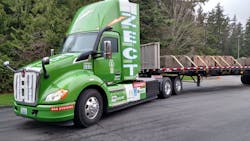Hydrogen, Batteries Power Kenworth Prototype
Though its fuel cell-electric heavy truck is still early in its development phase, Kenworth Truck Co. is describing it as the possible future of on-road hauling and perhaps vocational trucks, at least in areas where authorities are demanding ever-lower exhaust emissions.
Called Zero Emissions Cargo Transport, or ZECT, the highly modified T680 daycab tractor has a hydrogen fuel cell and electric motor instead of a diesel. The cell produces high-voltage DC electricity that’s fed to the battery pack and, inverted to AC, to the dual-stator and -rotor motor. This sends horsepower and torque through a four-speed automated transmission to conventional tandem rear axles. (Photo, below: An 85-kilowatt-hour fuel cell under the hood and 100-kilowatt-hour battery pack under the cab replace a diesel engine. The result is zero exhaust emissions, something coveted by clean-air authorities in California.)
“Quietness is good for the driver but not so good for a manufacturer,” said Brian Lindgren, KW’s research and development manager. “You start to hear things that you didn’t hear before, like rattles and squeaking panels in the interior.” There was some of that while under full throttle, and some vibration seemed to come from the driveline, maybe a maladjusted U-joint, I guessed.
Performance was brisk at start out but only adequate thereafter, because output was limited to a little more than half the motor’s 560-horsepower maximum. This was done to protect the transmission until shifting logic in its electronic controls is worked out, he explained. The motor spun much faster than a diesel, operating at 2,000 to 3,750 rpm, according to the tachometer. Top speed is 65 mph, but short straightaways and curves on our route limited our velocity to about 45 mph, just after shifting into 4th gear.
Uncertain shifting sent the Eaton tranny into “safe” shutdown mode, stalling the truck once for me and several times for other drivers. The temporary fix was to turn off the ignition key, then restart it. Software refinement should permanently remedy this glitch, Lindgren said. Improper sealing of exhaust piping allowed steam-like water vapor, the fuel cell’s only emissions, to float from under the hood when the truck stopped.
The truck’s imperfections belie its high cost – about $7 million -- Lindgren said. That covers the now exotic powertrain components: the Ballard cell; the Xalta battery pack; the Borg-Warner motor; numerous fans, pumps and heat exchangers from various sources; and electronic controls assembled by Kenworth and BAE Systems engineers. ll the work of putting them together and getting them to work has also been costly.
The truck’s tare weight is about 22,000 pounds, or 8,000 pounds more than a standard diesel-powered daycab T680, Lindgren said. That weight penalty is expected to come down as advances are made in li-ion batteries and other components. The battery pack alone weighs 2,000 pounds and the fuel cell 1,500 pounds. In addition to the large driveline motor, smaller motors run the truck’s air compressor, power steering and air conditioning compressor.
Much of the development is being funded by government money from the U.S. Department of Energy and the California Energy Commission. Southern California is where the tractor will work, pulling cargo containers out of the ports of Los Angeles and Long Beach. It’s slated to be turned over to Total Transport Services, a drayage operator that has run other prototype tractors in the area.
A battery-electric powertrain is another way to achieve the zero emissions wanted by California authorities, but such trucks have limited range.. The fuel cell is a “range extender,” lengthening a truck’s operating radius from the ports. Hydrogen was chosen because it’s “sustainable” and emits no pollutants.
Will this fuel cell hold up in a vocational truck? “We’re going to find out,” said Lindgren during a briefing for reporters at the start of the day. “They’re OK for buses. About 200 of them are now being used in buses, which bump along on city streets. Are they OK for construction trucks? We don’t know yet.”

